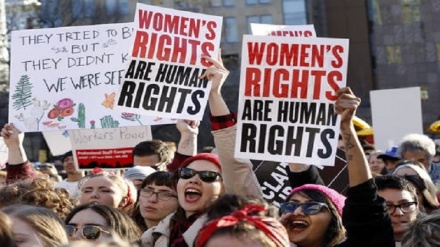Status of Women in the West (10)
After the Industrial Revolution, the production centers in the world demanded for employment of more workforce. Naturally, the employers wanted cheap workforce and this brought the employment of women to the center of focus in the west.
American historian, Will Durant, writes that women were cheaper laborers and employers preferred them to rebellious and expensive men. In spite the passage of two centuries from the Industrial Revolution and the slogans of the west on the equality of men and women, women continue to be discriminated at workplaces.
One of the most important issues on the gender inequality at workplaces in the west is that women earn lower salaries than men. Roth Pearson of Leeds University says that although each of the female workers feels the freedom of having independent income and increase of economic independence, every woman knows that her salary is much lower than what is paid to men.
During the past decades a number of the western countries, including those of the Scandinavia and Australia, have witnessed good progress in creation of gender equality especially on education and work; but women continue to receive less money than men; and they will hardly ever enjoy job promotion.
According to the report of World Economic Forum, even Iceland with the top rank in economic equality between genders, women's income is 75% of men. Sweden stands in the fourth rank of WEF's report. In Switzerland, despite equal education of women and men and high rate of participation of women at various jobs, women get lower pay in comparison with men. Limitation on some jobs and low salaries have made women intended to choose part-time jobs. Presently, the gender pay gap between is 7% to the favour of men in Switzerland. In Canada, too, despite efforts to reduce gender pay inequality, women are paid 88 cents for an hour while men are paid 1 dollar for an hour.
The Organization of Economic Co-operation and Development (OECD), which releases periodically the figures of the member states' economic performance and the results of economic research about the global economy prospect, has recently reported that there has been little improvement in the removal of gender pay inequality in the member states. In France, women's average income is 10% lower than men. According to the comparison of the US Statistics Office on the wages of women and men for the same jobs with equal worktime, women were paid 22% less than men in 2014. The gender pay gap in the western societies is not limited to public jobs and includes even the cinema. In 2014, the total salary of the top 10 Hollywood female stars was 26 million dollars. But the male stars were very much well-off and the 10 top stars gained double the amount of money paid to women, i.e. 419 million dollars.
According to the Center for the Study of Women in Television and Film, only 12% of the main roles of bestselling movies go to women and none of the main female stars was more than 45 years old. Meryl Streep said that gender discrimination has made filmmaking difficult for women in Hollywood. In spite of winning Oscars for the best woman's role, she was paid much less than men.
Now let us listen to the remarks of Ms. Akhundan,
"Formation of a social system based on gender equality is the fundamental issue of Feminism. However, efforts for gender pay equality is of paramount importance. According to a report on the economic inequality in the world, nearly 250 million women have entered the job market in the past decade. In several countries, the number of female university students has surpassed male students; but the point to note is that promotion of women's education hasn't necessarily led to gaining high posts and key positions by women. Women are paid half of men and this means a 58% economic gap between men and women. The information gathered in this report shows that the average salary of women today is equal to the salary of men 10 years ago. WEF, referring to the statistics of International Labour Organization, United Nations Development Programme and World Health Organization, announced that no country in the world has filled this gap."
The results of a research indicate that women should wait for 217 years to receive as much salary as men for the same job. This figure shows that the biggest gender pay gap has taken place in the past decade. Experts maintain that the gender pay gap has various causes. First, women are generally unable to bargain for higher payment. Secondly, in the periods of pregnancy and delivery they are forced to leave the workplace for some time. This has imperiled women's job security and given their employers the excuse to oppress them. Finally, this issue that can indirectly be included here is the sexual violence which women routinely face in workplaces. This violence forces women prefer more secure jobs with low wages to the jobs with higher payments.
As per the information, western women not only get less money compared with men but they also work longer hours. The statistics released in the developed countries indicate that women, both those who are employed and others, work 8 hours and 9 minutes per day averagely; whereas men work 7 hours and 36 minutes. The UN reports are indicative that in the developed economies, women spend at least 9 hours and 20 minutes in workplaces, no matter if they receive salary or not. But men in the same countries spend 8 hours and 7 minutes for the same jobs. Furthermore, women face 2.5 times more disorder in payment compared with men. This job discrimination has not been formed according to the ability and competence but because of gender inequality and has hindered the growth and progress of women in workplaces. In Germany, for instance, women occupy just a meager 6.7% of high level jobs. In the US, too, most of the owners of giant industries and tycoons are men. The studies of British Association of Journalists reveal that in 9 papers published in 2012 in Britain, 82% of the main titles were written by men leaving only 18% for women.
Studies in Europe and America show that the number of the male writers in media is four times more than the female. Next time we will further elaborate the issue.
RM/SS


